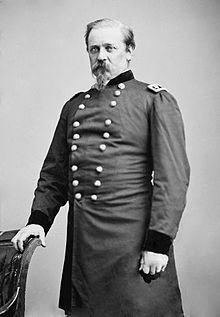William Farrar Smith
William Farrar Smith | |
|---|---|
 William Farrar "Baldy" Smith | |
| Born | February 17, 1824 St. Albans, Vermont, US |
| Died | February 28, 1903 (aged 79) Philadelphia, Pennsylvania, US |
| Place of burial | |
| Allegiance | |
| Service/ | United States Army Union Army |
| Years of service | 1845–1867 |
| Rank | |
| Commands held | VI Corps IX Corps XVIII Corps |
| Battles/wars | American Civil War
|
| Signature | |
William Farrar Smith (February 17, 1824 – February 28, 1903), known as "Baldy" Smith, was a
Early life
Smith, known to his friends as "Baldy", was born at
During his service in the Corps, Smith conducted surveys of the Great Lakes, the states of Texas, Arizona, and Florida, as well as much of Mexico. While serving in Florida, Smith was stricken with the infectious disease malaria. Although he would recover at the time, the illness affected his physical health for the rest of his life. In 1856 Smith began his involvement in the lighthouse service, which was headquartered in Detroit, Michigan, and eventually rose to become the Engineer Secretary of the Lighthouse Board.
Smith was also twice assistant professor of
Civil War
Smith was commissioned the colonel of the Third Vermont on July 23, 1861, but dated from April 27, making him the ranking officer of Vermont troops. On August 13, 1861, he was appointed a brigadier general in the Union Army after helping organize the 1st Vermont Brigade. He was appointed a brevet lieutenant colonel in the regular army for his gallantry at the Battle of White Oak Swamp in the Seven Days Battles. On July 4, 1862, he received promotion to the rank of major general in the Union Army. Smith led his division with conspicuous valor during the Battle of Antietam, and was again brevetted in the regular army. When his corps commander, Maj. Gen. William B. Franklin, was reassigned to a superior command, Smith was placed at the head of the VI Corps of the Army of the Potomac, which he led at the disastrous Battle of Fredericksburg.[4]
The recriminations that followed Fredericksburg led to a famous general order in which army commander Maj. Gen.
.On October 3, 1863, Smith was assigned to duty as chief engineer of the

For the
Postbellum career
Smith resigned from the volunteer service in 1865, and from the U.S. Army in 1867. From 1864 to 1873 he was president of the International Telegraph Company, and from 1875 to 1881 served on the board of police commissioners of New York City, becoming its president in 1877. After 1881 he was engaged in civil engineering work in Pennsylvania.[4] He died at Philadelphia in 1903 and is buried in Arlington National Cemetery.[6] His Autobiography of Major General William F. Smith, 1861–1864 was published posthumously in 1990.[7]
See also
References
This article includes a list of general references, but it lacks sufficient corresponding inline citations. (June 2020) |
- ^ ISBN 978-1-4766-8613-4
- ^ "Vermont Historical Society" (PDF). vermonthistory.org.
- ^ ISBN 978-0-8047-3641-1
- ^ a b c d Chisholm 1911.
- ^ Johnson, Robert Underwood, and Clarence C. Buel, eds. Battles and Leaders of the Civil War. 4 vols. New York: Century Co., 1884–1888.
- ^ Burial Detail (directions): Smith, William F – ANC Explorer
- ISBN 978-0-89029-534-2
Further reading
- This article incorporates text from a publication now in the public domain: Chisholm, Hugh, ed. (1911). "Smith, William Farrar". Encyclopædia Britannica. Vol. 25 (11th ed.). Cambridge University Press. p. 271.
- Warner, Ezra J. Generals in Blue: Lives of the Union Commanders. Baton Rouge: Louisiana State University Press, 1964. ISBN 978-0-8071-0822-2.
External links
 Media related to William Farrar Smith at Wikimedia Commons
Media related to William Farrar Smith at Wikimedia Commons
